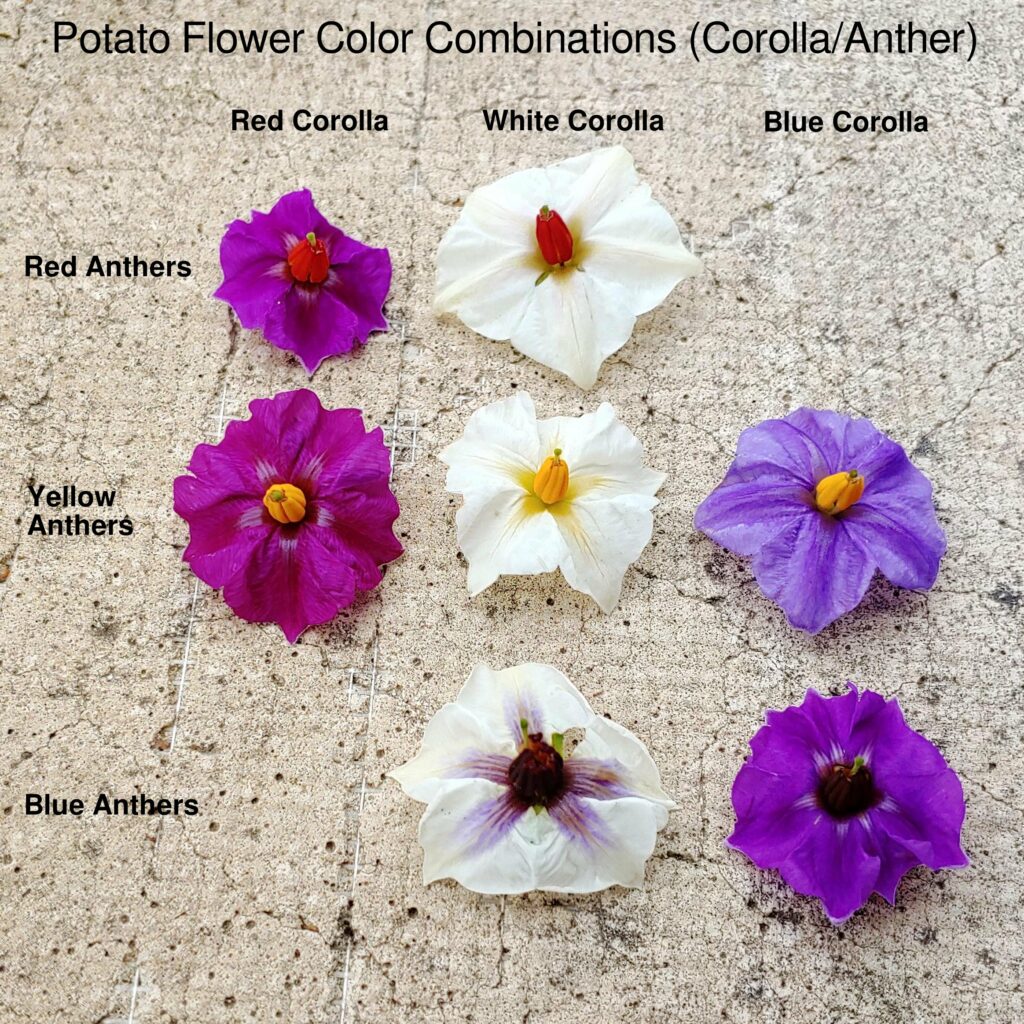potato (Solanum tuberosum)
What Potato Flowers Can Tell You About Tuber Color
Potatoes come in many colors. Tuber skin can be white, yellow, blue, or red and so can the flesh of the tuber. (I am referring here to the color of the pigments produced by the plant, so what you might describe as colors ranging from pink to magenta or powder blue to violet, I will describe simply as red or blue.) Similarly, potato flowers can be white, blue, or red in combination with anthers that can be yellow, blue, or red. These traits are linked, but not perfectly, so potato flower colors can give you clues about the skin and flesh color of the tubers, but there are limitations to their predictive power.
Anther color and corolla color can tell you a lot about the possible skin and flesh color of the tubers. Anther color is the better indicator, as blue or red anthers always signal corresponding tuber color. Yellow anthers indicate that the tubers will lack blue or red color in the tuber flesh, but tell you nothing about the skin color and yellow anthers in combination with a blue or red corolla only tell you that there is a possibility of blue or red tuber skin. I used flowers with fully blue or red anthers as my models for the picture, but is is more common for the anthers to be striped or mottled combinations of yellow with red or blue. I think that the degree of uniformity in the anthers relates to the uniformity of the flesh color, but I don’t have enough data to be confident about that. Occasionally, you will see a variety with yellow anthers that produces a little bit of color in the flesh, but I have noticed that if I pay careful attention to the flowers, I will often spot a few that have just a little bit of color in the anthers, so I’m not sure whether there are true cases of pure yellow anthers with colored flesh or not.
Anther color can be inconsistent, particularly in hot temperatures, so this could lead you astray. Anthers that have a little bit of color in cool temperatures may be totally yellow in hot weather. Some flowers also have anthers that are more green than yellow, a trait that is commonly associated with male sterility.
| Anther Color | Corolla Color | Predictions |
| Yellow | White |
White corollas are the least predictive color because they can indicate that either the plant does not produce pigments or that they are just not distributed to the flower. So, a plant with a white corolla could produce tubers with white, yellow, blue, or red skin. The lack of any pigment in the corolla indicates that the flesh will probably be white or yellow. I am not aware of any cases where a plant with purely yellow anthers has colored tuber flesh, although I’m not completely sure that it is impossible. |
| Yellow | Blue |
The skin color could be white, yellow, or blue. A blue corolla tells you that the plant produces blue pigment and that it is distributed to the flower, but it cannot tell you if it is distributed to the tuber. The lack of any pigment in the anthers indicates that the flesh will probably be white or yellow. |
| Yellow | Red |
The skin color could be white, yellow, or red. Just like with blue, a red corolla tells you that the plant produces red pigment, but not if it is distributed to the tuber. The lack of any pigment in the anthers indicates that the flesh will probably be white or yellow. |
| Blue | White or Blue |
Blue anthers indicate that the plant produces blue pigment and distributes it to the tuber. The tubers will be blue with at least partially blue flesh. The flesh color could range from fully blue to mostly white or yellow with just blue flecks or a blue ring. |
| Red | White or Red |
Red anthers indicate that the plant produces red pigment and distributes it to the tuber. The tubers will be red with at least partially red flesh. The flesh color could range from fully red to mostly white or yellow with just red flecks or a red ring. |
There are additional oddities in potato color for which the underlying genetics have not been described. For example, there are rare varieties that have blue skin with red eyes or that have white skin with red or blue flesh. Nature still has more mysteries for us to puzzle through.
If you want to understand potato color in greater depth, see my earlier post about potato color genetics.


This is so interesting, thanks so much for the overview. I am currently growing 12 potato plants from seeds that I picked up from an ‘Afra’ potato last year. So far, only slight differences in foliage colour, but different flower colours. Only yellow anthers so far, but not all flowers are open yet. I hope they will survive the blight long enough to produce some harvest :)
Have you ever encountered a yellow flower? I have not, but came across this photo online:
https://www.garden.eco/wp-content/uploads/2018/05/potato-flower.jpg
I think that is virtually certain to be a white flower that is tinted either by the natural light or processing by the camera. There is a variety with a yellow flower in Europe called Gelbblühender Stamm, but a close inspection of the flowers of that variety reveals that they are partially fused with anthers, which is the source of the yellow. As far as I know, potatoes do not have genes that allow for the production of yellow pigments in the corolla.